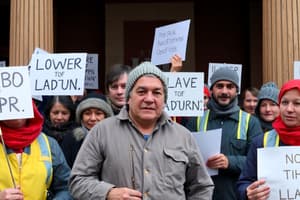Podcast
Questions and Answers
What compensation is a worker entitled to if there is a substantial modification of work conditions and they can prove it is damaging to their dignity?
What compensation is a worker entitled to if there is a substantial modification of work conditions and they can prove it is damaging to their dignity?
- 20 days of salary for every year worked up to 9 months (correct)
- 15 days of salary for each year worked
- No compensation if they decide to quit
- One month salary based on their last pay
Which of the following rights is NOT granted to a victim of gender violence in the workplace?
Which of the following rights is NOT granted to a victim of gender violence in the workplace?
- Request for a reduction of working hours with corresponding salary reduction
- Justification for absences confirmed by social services
- Right to a flexible timetable
- Request for a suspension of employment for up to 12 months (correct)
If an employer dismisses a victim of gender violence while they are entitled to rights related to that status, how is such a dismissal classified?
If an employer dismisses a victim of gender violence while they are entitled to rights related to that status, how is such a dismissal classified?
- As a valid dismissal if formally documented
- As a disciplinary dismissal with punitive measures for the employer
- As a collective dismissal subject to legal review
- As a null dismissal entitling the victim to free legal assistance (correct)
What is one possible benefit for companies that hire victims of gender violence?
What is one possible benefit for companies that hire victims of gender violence?
What occurs to the employment relationship when an employer dies and his heirs do not continue the business?
What occurs to the employment relationship when an employer dies and his heirs do not continue the business?
What best describes the scope of labour law as outlined by the Workers Statute?
What best describes the scope of labour law as outlined by the Workers Statute?
Which of the following principles is NOT currently governing the application of Labour Law regulations?
Which of the following principles is NOT currently governing the application of Labour Law regulations?
Which of the following statements about ancient labor conditions is correct?
Which of the following statements about ancient labor conditions is correct?
During which historical period was the concept of 'locatio conductio operis' primarily used?
During which historical period was the concept of 'locatio conductio operis' primarily used?
Which aspect of Labour Law emphasizes that rights cannot be waived or given up?
Which aspect of Labour Law emphasizes that rights cannot be waived or given up?
What was the relationship structure between feudal lords and serfs during the Middle Ages?
What was the relationship structure between feudal lords and serfs during the Middle Ages?
What differentiates 'locatio conductio operarum' from 'locatio conductio operis'?
What differentiates 'locatio conductio operarum' from 'locatio conductio operis'?
What emerged as the earliest form of collective worker protection before the establishment of formal labor laws?
What emerged as the earliest form of collective worker protection before the establishment of formal labor laws?
Which factor contributed to the genesis of labor law through changes in work organization and population structure?
Which factor contributed to the genesis of labor law through changes in work organization and population structure?
What was a significant characteristic of capitalism during its early development in relation to state intervention?
What was a significant characteristic of capitalism during its early development in relation to state intervention?
In what way did the state initially approach the regulation of labor relations?
In what way did the state initially approach the regulation of labor relations?
What role did anarchism and Marxism play in the context of labor movements?
What role did anarchism and Marxism play in the context of labor movements?
In the context of labor law, which interest is primarily considered when defining labor regulations?
In the context of labor law, which interest is primarily considered when defining labor regulations?
What is one of the first rules established in labor law concerning working conditions?
What is one of the first rules established in labor law concerning working conditions?
What represents the judicial power's responsibility regarding labor relations?
What represents the judicial power's responsibility regarding labor relations?
What was the primary condition for members to join a guild historically?
What was the primary condition for members to join a guild historically?
What is the maximum number of hours a worker can legally work in a day according to the ordinary working day regulations?
What is the maximum number of hours a worker can legally work in a day according to the ordinary working day regulations?
Which of the following groups are prohibited from working at night?
Which of the following groups are prohibited from working at night?
What is the minimum rest period for workers over 18 years of age when their working day exceeds 6 hours?
What is the minimum rest period for workers over 18 years of age when their working day exceeds 6 hours?
According to collective agreements, if effective working time does not need to be recovered, what does not fall under this category?
According to collective agreements, if effective working time does not need to be recovered, what does not fall under this category?
What is the minimum break duration required for workers under 18 whose workdays exceed 4.5 hours?
What is the minimum break duration required for workers under 18 whose workdays exceed 4.5 hours?
How many uninterrumpted days of weekly rest must a worker have?
How many uninterrumpted days of weekly rest must a worker have?
What is the maximum contribution for overtime according to the ordinary working day norm?
What is the maximum contribution for overtime according to the ordinary working day norm?
Which condition best describes how working hours can be distributed throughout the year?
Which condition best describes how working hours can be distributed throughout the year?
Who is NOT permitted to work overtime according to the working regulations?
Who is NOT permitted to work overtime according to the working regulations?
What is the purpose of the norms regulating working hours according to the provided content?
What is the purpose of the norms regulating working hours according to the provided content?
What happens if the employer refuses to reinstate the employee?
What happens if the employer refuses to reinstate the employee?
When is the employee required to request reinstatement?
When is the employee required to request reinstatement?
For a worker from a large family, how long is the job position reserved?
For a worker from a large family, how long is the job position reserved?
What is the outcome of back pay if the reinstatement is delayed?
What is the outcome of back pay if the reinstatement is delayed?
Which statement is true regarding an employee taking leave of absence for family care?
Which statement is true regarding an employee taking leave of absence for family care?
In the context of leave, what does seniority affect?
In the context of leave, what does seniority affect?
What is required for an employee to attend training programs while on leave?
What is required for an employee to attend training programs while on leave?
What is true regarding simultaneous leave of absence for having another child?
What is true regarding simultaneous leave of absence for having another child?
What type of relatives allows for leave of absence to care for them?
What type of relatives allows for leave of absence to care for them?
What must happen if the employee seeks reinstatement but there is no available position?
What must happen if the employee seeks reinstatement but there is no available position?
Flashcards
Public Law
Public Law
A set of rules that govern the relationship between individuals and the state.
Private Law
Private Law
A set of rules that govern the relationship between individuals, where they are treated as equals.
Labour Law
Labour Law
A set of rules governing the relationship between workers and employers.
Trade Union Law
Trade Union Law
Signup and view all the flashcards
Collective Bargaining Agreements (CBAs)
Collective Bargaining Agreements (CBAs)
Signup and view all the flashcards
Free Will
Free Will
Signup and view all the flashcards
Dependent Relationship
Dependent Relationship
Signup and view all the flashcards
Pre-Capitalism
Pre-Capitalism
Signup and view all the flashcards
Guilds
Guilds
Signup and view all the flashcards
Capitalism
Capitalism
Signup and view all the flashcards
Urbanization
Urbanization
Signup and view all the flashcards
Laissez-Faire
Laissez-Faire
Signup and view all the flashcards
Capitalism
Capitalism
Signup and view all the flashcards
Labor Movement
Labor Movement
Signup and view all the flashcards
State Intervention in Labor
State Intervention in Labor
Signup and view all the flashcards
Substantial Modification of Work Conditions
Substantial Modification of Work Conditions
Signup and view all the flashcards
Gender Violence Victim Rights
Gender Violence Victim Rights
Signup and view all the flashcards
Employee Death in Employment
Employee Death in Employment
Signup and view all the flashcards
Dismissal of Employees
Dismissal of Employees
Signup and view all the flashcards
Employer Breach of Contract
Employer Breach of Contract
Signup and view all the flashcards
Working Time
Working Time
Signup and view all the flashcards
Maximum Working Hours
Maximum Working Hours
Signup and view all the flashcards
Effective Working Time
Effective Working Time
Signup and view all the flashcards
Non-Effective Working Time
Non-Effective Working Time
Signup and view all the flashcards
Rest Period for Adults
Rest Period for Adults
Signup and view all the flashcards
Rest Period for Minors
Rest Period for Minors
Signup and view all the flashcards
Minimum Rest Between Workdays
Minimum Rest Between Workdays
Signup and view all the flashcards
Weekly Rest
Weekly Rest
Signup and view all the flashcards
Overtime
Overtime
Signup and view all the flashcards
Night Work
Night Work
Signup and view all the flashcards
Professional Training Leave
Professional Training Leave
Signup and view all the flashcards
Job Position Reservation during Leave
Job Position Reservation during Leave
Signup and view all the flashcards
Employer Refusal to Reinstate
Employer Refusal to Reinstate
Signup and view all the flashcards
Back Pay (Salarios de Tramitacion)
Back Pay (Salarios de Tramitacion)
Signup and view all the flashcards
Extended Job Reservation for Large Families
Extended Job Reservation for Large Families
Signup and view all the flashcards
Seniority Calculation During Leave
Seniority Calculation During Leave
Signup and view all the flashcards
Contributions During Leave
Contributions During Leave
Signup and view all the flashcards
Leave for Subsequent Children
Leave for Subsequent Children
Signup and view all the flashcards
Working During Leave
Working During Leave
Signup and view all the flashcards
Leave to Care for a Family Member
Leave to Care for a Family Member
Signup and view all the flashcards
Study Notes
Labour Law Introduction
- Law is a set of rules for coexistence.
- Public law governs state-individual relations (administrative, procedural, criminal, taxation).
- Private law governs individual-individual relations (civil, commercial, international).
- Trade union law is concerned with collective bargaining agreements
Scope of Labour Law
- Workers' statute Art. 1: A set of social relationships where people carry out services for others.
- It applies to voluntary, remunerated, and dependent relationships involving services rendered on behalf of another person, based on personal qualifications, expertise, and skills.
Labour Throughout History
- Ancient Times: Manual labor, worker-slave relationship, only duties imposed by the master.
- Roman Empire: Distinction between labor (hard work) and work (creative activity), contracts between employers and freemen (e.g., locatio conductio operis, locatio conductio operarum).
- Middle Ages: Workers as slaves, freemen, and serfs with protection and land in exchange for harvest.
- Pre-Capitalism: Development of cities and trades; guild system.
- Capitalism: Industrial revolution, growth of factories, emigration, political and economic liberalism, exploitation of workers.
Guiding Principles of Labor Law
- Limitation of parties' free will (unlike civil law principle).
- More favorable rules and beneficial conditions (protected by law).
- Inalienability of worker rights (cannot be waived).
Factors Determining Labour Law
- Sociological factor: changes in work organization and population structure.
- Legal factor: liberal individualistic law and its dysfunction (freedom of contracting, unionism prohibition).
- Social factor: labor movement (worker collective actions, associations).
State Intervention in Labour Relations
- Aims to regulate working hours, employer/employee interests.
- Labour courts address disputes regarding labour matters.
- Specific judicial bodies (social labor courts, superior courts of justice, supreme court) handle labour issues.
Sources of Labour Law
- Shared with other legal systems (law/custom).
- General rules and sectorial rules (workers statutes, employment contract customs, general legal principles).
- National and international rules (Spanish constitution, collective agreements, employment contracts, International regulations and directives EU, Conventions and recommendations of ILO, international treaties, international jurisprudence).
Spanish Constitution and Democratic Rule of Law
- Principles of social and democratic rule of law (freedom, equality, justice, political pluralism).
- Recognition of trade unions and associations as representatives of collective interests.
- Fundamental rights, rights to work, sufficient remuneration, right to adopt collective conflict measures
International Labour Law -
- International labour organization (ILO)
- Bilateral and multilateral agreements
- EU legislation
Employment Contracts
- Workers' Statute (Art 1) defines employment contracts as voluntary, personal services rendered, dependent relationship to another party, remuneration . If element are missing it is not an employment contract
- Standard conditions, exchange of interest
- Probation period (limited time frame for trial period)
Types of Contracts
- Training contracts (alternating, temporary)
- Contracts to obtain professional practice
- Internship agreement
- Hand-over contract
- Indefinite contract
- Permanent discontinuous contract
- Part-time contract (after reform 2022)
Working Day
- Essential condition of labour relationship, limiting work performance.
- Working hours are regulated based on collective agreements or employment contracts.
- Maximum working hours (ordinary working day, 40 hrs a week).
- Breaks (rests)
- Protection of workers (health and safety).
Overtime
- Work performed beyond ordinary working hours.
Night Time Work
- Restrictions on working during night time hours, especially for minors.
- Regulations relating to night time conditions.
Vacations
- Duration and conditions (minimum 30 calendar days).
- Obligations related to vacation dates -
- Vacation period not compensated financially
Salarly
- Salary as the total economic compensation for work(cash or kind).
- Minimum Interprofessional Wage (minimum wage)
Remuneration Systems
- Techniques for establishing salary levels (job-based, expertise-based, or performance-based).
Labour Mobility
- Functional mobility: employer's ability to reassign tasks to an employee (horizontal/vertical).
- Geographic Mobility: changing workplaces and residence due to work. Additional considerations relating to transfer.
Limitations on Functional Mobility
- Heteronomous limits: imposed by constitutions.
- Autonomous limits: determined by contract (conventional, contractual)
Company Succession
- Transfer of undertakings (change of ownership).
- Effects on labor relationships. By inter vivos transmission or mortis causa.
- Subrogation.
Employee Rights
- Informative duties.
- Collective Agreements.
- Consultation periods
- Employee responsibilities.
Dismissal
- Collective, objective, disciplinary, and procedural processes.
- Specificities (cause, timeframes)
Right to Participate in the Company
- Trade unions and workers' representatives are key actors in the labour process
- Relevant duties and rights of workforce representatives
Procedure to a dismissal
- Procedure to follow.
- Conciliation procedures.
Alternative Dispute Resolution
- Mechanisms to negotiate or resolve disputes through mediation, arbitration or conciliation.
- Rights related to judicial protection
Labour Disputes
- Means of resolving labour disputes
- Strike rights
- Lock-out (shutdown of workers)
Studying That Suits You
Use AI to generate personalized quizzes and flashcards to suit your learning preferences.




